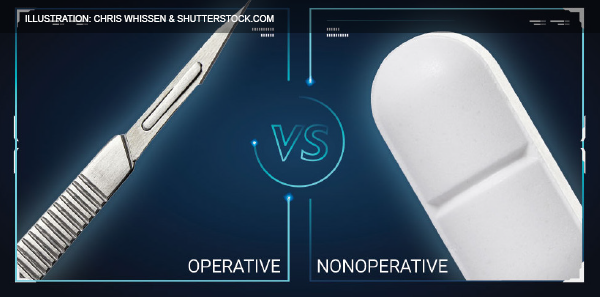
The Case
Johnny is a 10-year-old boy who presents to the emergency department after a 24-hour history of abdominal pain. It started in the periumbilical region and is located in the right lower quadrant. The pain is increasing in severity. His mother knew something was wrong when he did not want to eat dinner or play soccer with friends after school. He was nauseated and developed a low-grade fever. On examination, he is maximally tender over McBurney’s point. An ultrasound confirms acute, uncomplicated appendicitis.
Explore This Issue
ACEP Now: Vol 36 – No 07 – July 2017Background
One of the most common pediatric surgical emergencies is appendicitis. The peak incident is in the second decade of life, with a lifetime risk of 7 percent to 8 percent.1
The standard treatment for acute appendicitis, ever since Dr. Charles McBurney described it in 1889, has been appendectomy.2 This surgical approach has been highly successful for more than a century.
There have been a number of recent publications suggesting a nonoperative treatment (NOT) of appendicitis in adults.3,4 They propose using antibiotics rather than surgery to manage this common condition.
Clinical Question
Is NOT safe and effective in pediatric patients with acute, uncomplicated appendicitis?
Reference
Georgiou R, Eaton S, Stanton MP, et al. Efficacy and safety of nonoperative treatment for acute appendicitis: a meta-analysis [published online ahead of print Feb. 17, 2017]. Pediatrics. 2017:139(3).
- Population: Patients under 18 years of age with acute, uncomplicated appendicitis.
- Exclusions: Complicated appendicitis (ie, perforation, rupture, abscess, or appendix mass), studies of mixed adults and children, or studies of acute appendicitis only in children with malignancy.
- Intervention: Intravenous antibiotics.
- Comparison: Primary appendectomy.
- Outcomes:
- Primary: Discharge from hospital without appendectomy.
- Secondary: Serious adverse effects of NOT, complications, long-term efficacy (no appendectomy at final reported follow-up), recurrent appendicitis (confirmed by histology or treated with second course of NOT), and hospital length of stay.
Authors’ Conclusion
“Current data suggest that NOT is safe. It appears effective as initial treatment in 97 percent of children with acute, uncomplicated appendicitis, and the rate of recurrent appendicitis is 14 percent. Longer-term clinical outcomes and cost-effectiveness of NOT compared with appendectomy require further evaluation, preferably in large randomized trials, to reliably inform decision-making.”
Key Results
Ten studies were included that had a total of 413 pediatric patients selected or randomized to NOT.
Primary Outcome: NOT was successful in 97 percent of cases (95% CI, 95–99%).
Secondary Outcome:
Serious Adverse Events: None reported.
Long-Term Efficacy of NOT: 82 percent (95% CI, 77–87%).
Recurrent Appendicitis: 14 percent (95% CI, 7–21%).
Hospital Length of Stay: Mean difference 0.5 days fewer with appendectomy (95% CI, 0.2–0.8; P=0.002).
Evidence-Based Medicine Commentary
Quality of Studies: Nine of the 10 studies were observational studies. This is a low level of evidence. Only associations can be concluded, not cause and effect. Four of these studies had no comparison group. Only one small randomized pilot study of 50 patients was included.
Pages: 1 2 | Single Page






No Responses to “Latest Research on Nonoperative Treatment of Appendicitis in Pediatric Patients”